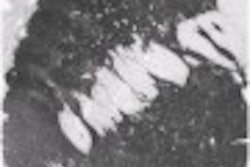Right from the start, PET imaging proponents in the U.S. have faced an uphill battle in their bid to win reimbursement from the Centers for Medicare and Medicaid Services (CMS). And because private healthcare insurers typically rely on CMS coverage decisions to guide their own reimbursement rules, the HMO/PPO payment path hasn't exactly been PET-friendly either.
Hoping to prod the government into action, physician associations such as the Society of Nuclear Medicine in Reston, VA, and the Academy of Molecular Imaging (AMI) in Los Angeles have put CMS approval of Medicare coverage for PET at the forefront of their lobbying efforts.
On March 1, CMS will complete its national coverage analysis (NCA) for reimbursement for the diagnostic use of FDG-PET for soft-tissue sarcoma and also for thyroid cancer. On March 3, CMS is scheduled to deliver its NCA decision on the diagnostic use of N-13 ammonia as a myocardial perfusion tracer -- in combination with FDG as the viability tracer -- in PET imaging. The soft-tissue sarcoma and thyroid cancer requests for NCA were made in 2001; the N-13 ammonia request was made in 2002.
Long waits are simply a part of the landscape when dealing with CMS, according to Ruth Tesar, executive director of Northern California PET Imaging in Sacramento.
"The Medicare Coverage Advisory Committee decision process is lengthy and, at times, arduous," she said. Tesar outlined the progress made in PET coverage over the last five years during a presentation at the 2002 AMI conference in San Diego.
"The good news from a coverage standpoint is that of the approximately 1.3 million patients with cancer indicators in the U.S. in 2002, 720,300 of these patients, or 56%, were covered for PET studies," she said.
The Medicare reimbursement decision that had a major impact on PET use in a clinical setting was made in 1998, according to Tesar. That year, the Health Care Financing Administration (HCFA, the precursor to CMS) developed a coverage policy for FDG-PET imaging for solitary pulmonary nodules and staging non-small cell lung cancer.
In 1999, HCFA added the detection of colorectal cancer with rising CEA; the detection of recurrent malignant melanoma; and the staging and restaging of Hodgkin’s and non-Hodgkin’s lymphoma to its coverage policies for FDG-PET.
The following year was a watershed for the recognition of PET as a molecular diagnostic imaging modality by the CMS.
"In July 2000 a document from the University of California at Los Angeles and Duke University (Durham, NC) was submitted to the HCFA for broad coverage of PET. That document summarized FDG-PET literature in oncology, cardiovascular disease, epilepsy, and dementia. Approximately 16,000 patient studies were included in the 450 summarized articles. It was later expanded to include data on more than 24,000 patients from 643 articles," Tesar said.
This yeoman effort resulted in a decision memorandum issued by HCFA in December 2000, officially recognizing PET as a molecular diagnostic imaging modality for detecting and characterizing the biology of disease. According to Tesar, as a result of this recognition, the HCFA memorandum went on to note the following items:
- Broad coverage for the diagnosis, staging and restaging of non-small cell lung cancer, esophageal cancer, colorectal cancer, lymphoma, melanoma, and head and neck cancers.
- Myocardial viability was also covered if an inconclusive SPECT scan was initially obtained.
- Pre-surgical evaluation of refractory seizure disorder was covered.
- Indications for breast cancer and Alzheimer’s disease were referred to the Medicare Advisory Committee (MCAC) Diagnostic Imaging Panel for review in 2001.
- Coverage was restricted to dedicated PET scanners and coincidence cameras with 5/8ths-inch sodium iodide detectors.
The past two years have seen some huge wins in terms of coverage decisions for the modality, Tesar said. But PET proponents have also suffered some setbacks.
In 2001, CMS announced that, effective for indications covered for reimbursement beginning in July of that year, only studies performed on dedicated PET scanners would be covered. However, the indications covered for coincidence cameras before that time would remain eligible for reimbursement. Also that year, the CMS MCAC recommended FDG-PET coverage for imaging recurrent metastatic breast cancer.
Setbacks occurred during 2002 in getting an MCAC recommendation for the reimbursement of PET in Alzheimer’s imaging, which was denied, and for the diagnosis of thyroid cancer, which was denied due to inadequate data.
"The request for review for the use of FDG-PET in staging thyroid cancer was resubmitted with additional data, and the effort for the reconsideration of FDG-PET for Alzheimer’s disease is ongoing," Tesar said.
As part of its ongoing effort to expand covered PET procedures, the AMI is in the process of submitting reimbursement requests for FDG-PET procedures for ovarian cancer, pancreatic cancer, brain tumors, and other cancers, she also noted.
Although Tesar said positive changes have been made in reimbursement coverage, payment levels have eroded.
"The original reimbursement level for the first FDG-PET oncology procedures Medicare covered was $2,331. But the agency has steadily managed to reduce that amount, and PET is now reimbursed at a much lower rate. PET imaging providers must be consistently diligent in keeping abreast of payment trends and coverage policies," she advised.
By Jonathan S. BatchelorAuntMinnie.com staff writer
February 26, 2003
Related Reading
Imaging market notches 10% growth, with no sign of fatigue, February 13, 2003
Good news on PET reimbursement lifts vendors’ spirits, December 1, 2003
Hands-on PET training features physician mentoring, November 29, 2002
CMS to maintain PET payment rates, November 8, 2002
Wagner sees bright future for molecular imaging, October 31, 2002
Copyright © 2003 AuntMinnie.com



















